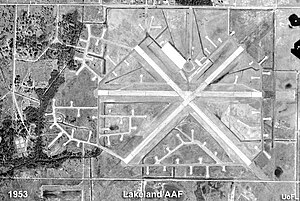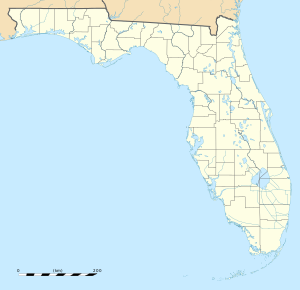Lakeland Army Air Field
| Lakeland Army Airfield | |
|---|---|
| Part of Third Air Force | |
| Located near: Lakeland, Florida | |
 Lakeland Army Airfield in 1953, at that time unused and in its World War II configuration. Lakeland Army Airfield in 1953, at that time unused and in its World War II configuration. | |
| Coordinates | 27°59′20″N 082°01′07″W / 27.98889°N 82.01861°W |
| Site history | |
| In use | 1942-1945 |
Lakeland Army Airfield, was a
History
Origins
On May 22, 1941, the Lakeland City Commission passed a Resolution naming the Lakeland Airport No. 2, which was under construction, Drane Field in honor of Herbert J. Drane, one of Lakeland's outstanding citizens.
The city had barely begun work on the new airport when, with
In early May 1942, enough construction was completed to dedicate the new military base, named Lakeland Army Air Field. The base was assigned to the
In May 1942, however, the airfield was not yet ready to support the flying training mission. Construction delays limited the operational use of the field, and
III Bomber Command
The first flying unit to arrive at Lakeland AAF was the
The next unit, arriving shortly afterwards, was the
The
The
In October 1943, the
In late 1943, when
It was soon found that Lakeland AAF was not suitable for B-17 training because the asphalt runways could not withstand the weight of the heavy bombers, and the 463d was the first and last heavy bomber group to train at Lakeland. The
III Fighter Command
The AAFSAT training mission ended in mid-March 1944, when Lakeland was officially reassigned to III Fighter Command. Air Service Command, which has been using Lakeland as a staging base for new Service Units, remained at Lakeland after the transfer to Fighter Command. The 352d Army Air Forces Base Unit (Replacement, Fighter), was activated at the base as a replacement personnel training unit. With the transfer to Fighter Command, Lakeland became a main operating base for Third Air Force.
A different mission of sorts was ordered by III Fighter Command, the training of Air Commando fighter units for the
The
With the Air Commando training completed, the
Closure
The training mission ended with the departure of the P-51 squadrons for the Pacific, and the 352d AAFBU was inactivated at the end of February. The Air Service Command mission continued however, and the airfield remained open; mostly seeing transient training aircraft from various training bases in Florida and South Georgia. The number of personnel were reduced, being reassigned to other bases, and in mid-April 1945, orders were received from Third Air Force that Lakeland Army Airfield would be closed on 30 April 1945 and placed in a standby status.
The facility was subsequently transferred to
The facility, however, was vastly larger in scope with large numbers of support buildings and other improvements than the one leased to the War Department in 1940. After the war ended, the Army Airfield was left mostly unused due to the size of the facility far exceeding the needs of the city as well as the costs involved of converting it to civil use.
Drane Field, was essentially abandoned for the next decade. With the closure of Lodwick Aircraft at
Major units assigned
Air Service Command
- 323d Service Group (1942)
- 324th Service Group (1942)
- 40th Service Group, 1 January 1944-
- Re-designated: 4501 Army Air Forces Base Unit (Service Group), 1 March 1944-April 1945
III Bomber Command
- 60th Flying Training Detachment (Medium Bombardment)
- 320th Bombardment Group8–28 August 1942, (B-26, 3d Level Training)
- 322d Bombardment Group22 September–November 1942, (B-26, 3d Level Training)
- 344th Bombardment Group, 28 December 1942 – 19 December 1943 (B-26 OTU)
- 557th Bombardment Squadron, 12 April-12 May 1943 (B-26, 2d Level Training)
- 407th Fighter-Bomber Group(Dive), 2 October-9 November 1943 (A-36 OTU)
- 463d Bombardment Group, 3 January-2 February 1944 (B-17 3d Level Training)
Army Air Forces School of Applied Tactics
- 410th Bombardment Group(Light), 8 February-13 March 1944 (A-20)
III Fighter Command
- 352d Army Air Forces Base Unit (Replacement, Fighter), 1 May 1944-March 1945
- 3d Air Commando Group, 5 May-20 August 1944
- 1st Fighter Squadron (Commando), 22 August-23 October 1944 (P-51)
- 2d Fighter Squadron (Commando), 22 August-23 October 1944 (P-51)
- 127th Liaison Squadron (Commando), 22 August-23 October 1944
- 155th Liaison Squadron (Commando), 22 August-23 October 1944
- 156th Liaison Squadron (Commando), 22 August-23 October 1944
- 457th Fighter Squadron, 21 October 1944 – 16 February 1945 (P-51)
- 462d Fighter Squadron, 21 October 1944 – 16 February 1945 (P-51)
Triple cross
The three runways intersect at three points rather than a single "triple cross" so that repairs or cleaning can be carried out at one of the intersections, while one runway remains usable.
See also
References
![]() This article incorporates public domain material from the Air Force Historical Research Agency
This article incorporates public domain material from the Air Force Historical Research Agency
- ^ Guinn, Christopher. "Now it's an international airport: US Customs clears 1st Lakeland Linder border crossing". www.theledger.com. The Ledger. Retrieved 11 September 2018.
- Maurer, Maurer (ed.). Combat Squadrons of the Air Force: World War II. ISBN 0-405-12194-6.
- Maurer, Maurer (ed.), Air Force Combat Units of World War II, History and Insignia, USAF Historical Division, Washington, DC, 1961 (reprint 1983) ISBN 0-89201-092-4
- AFHRA search Lakeland Army Airfield
- World War II airfields database: Florida



